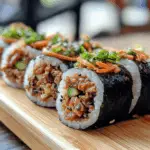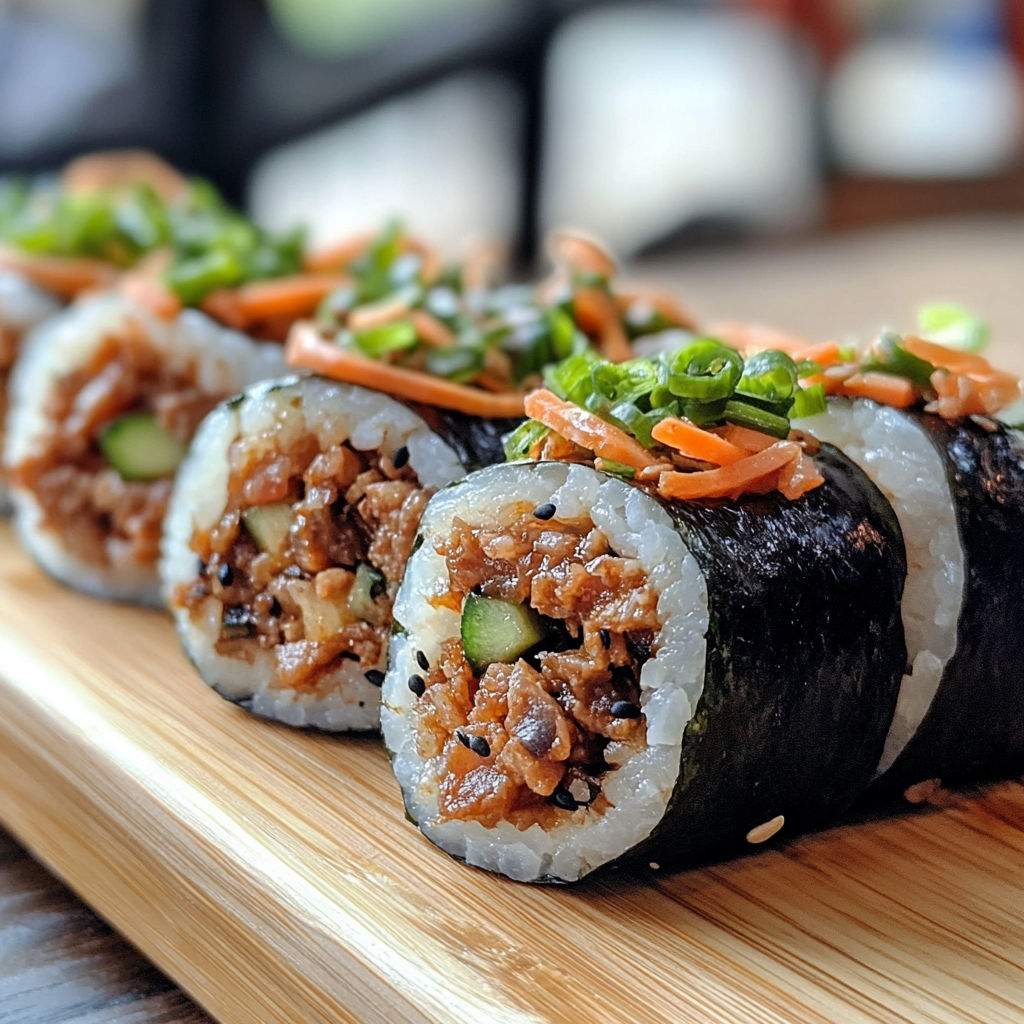Sushi gets a Korean twist in this bold and flavorful Korean Bulgogi Sushi Rolls recipe. Combining the sweet-savory richness of marinated bulgogi beef with the freshness of crisp vegetables, sesame-scented rice, and uniquely Korean ingredients like perilla leaves and yellow pickled radish, these rolls are both satisfying and visually stunning. Wrapped in roasted seaweed and cut into bite-sized rounds, each piece delivers a perfect balance of texture and flavor that will leave you reaching for more.
This dish, also known as “Bulgogi Gimbap,” is a creative, Korean-inspired version of traditional Japanese sushi. It’s ideal for gatherings, lunchboxes, or an elevated homemade meal. Unlike sushi, these rolls don’t require raw fish, making them more accessible and family-friendly. The seasoned rice and variety of fillings offer a depth of taste, while perilla leaves introduce a slightly minty, earthy aroma that complements the beef perfectly. These rolls are as fun to make as they are to eat, and once you try them, you’ll understand why they’re a staple in many Korean households.
Why You’ll Love This Recipe
- Fusion of Korean and Japanese Flavors: A delicious cultural blend that delivers both comfort and novelty.
- Great for Meal Prep: Perfectly portable and keeps well for lunches or picnics.
- Customizable Fillings: Easily adapted to suit your taste or what you have on hand.
- Balanced and Nutritious: Includes protein, veggies, and healthy carbs in every bite.
- Eye-Catching Presentation: Beautiful, colorful rolls that impress at first glance.

Ingredients
- Roasted Korean seaweed sheets (or sushi seaweed)
- Steamed short grain rice
- Roasted sesame seeds
- Korean perilla leaves
- Cooked bulgogi (Korean marinated beef)
- Korean yellow pickled radish (strips)
- Seasoned burdock root strips
- Cucumber (seeds removed, julienned)
- Carrot (julienned)
- Sesame oil
Variations
- Vegetarian Option: Replace bulgogi with marinated tofu or sautéed mushrooms.
- Spicy Kick: Add a thin layer of gochujang or spicy mayo to the rice before rolling.
- No Perilla? Use fresh spinach leaves or omit entirely.
- Bulgogi Chicken: Use the same marinade for chicken if beef isn’t your preference.
- Rice Alternatives: Mix in quinoa or cauliflower rice for a lower-carb option.
How to Make the Recipe
Step 1: Prepare the Rice
Cool the steamed short grain rice slightly, then mix with sesame oil and roasted sesame seeds for extra flavor.
Step 2: Lay the Seaweed
Place one sheet of roasted seaweed (shiny side down) on a bamboo sushi mat lined with plastic wrap.
Step 3: Spread the Rice
Evenly spread a thin layer of seasoned rice over two-thirds of the seaweed, leaving the top edge empty for sealing.
Step 4: Layer the Fillings
Place two perilla leaves over the rice. Then, horizontally arrange cooked bulgogi, yellow radish, burdock root, julienned cucumber, and carrot in the center.
Step 5: Roll the Sushi
Using the sushi mat, roll tightly from the bottom up, gently pressing to secure the shape. Seal the edge with a little water or rice.
Step 6: Slice the Rolls
Brush the roll lightly with sesame oil and slice into ½-inch thick rounds using a sharp, wet knife.
Step 7: Serve
Arrange rolls on a platter and garnish with extra sesame seeds if desired. Serve with soy sauce or wasabi mayo for dipping.

Tips for Making the Recipe
- Keep your hands wet to prevent rice from sticking while spreading.
- Use a very sharp knife for clean cuts. Wipe it between slices for best presentation.
- Chill rolls slightly before slicing for easier handling.
- Don’t overfill—too many ingredients will make rolling difficult.
- Use a bamboo mat for tighter, more uniform rolls.
How to Serve
These sushi rolls are best served fresh, either slightly chilled or at room temperature. Pair them with a side of kimchi, a bowl of miso soup, or pickled ginger. They make a fantastic appetizer, party platter, or lunchbox addition. For an elegant touch, serve with a small dish of soy sauce mixed with a dash of sesame oil or chili flakes.
Make Ahead and Storage
Storing Leftovers
Wrap any leftover rolls tightly in plastic wrap and store in the refrigerator. They’re best eaten within 24 hours for maximum freshness.
Freezing
Not recommended, as the texture of rice and vegetables can degrade when frozen and thawed.
Reheating
These are meant to be enjoyed cold or at room temperature. If desired, individual slices can be gently warmed in a skillet for a toasted variation.
FAQs
1. Can I use regular sushi rice instead of Korean short grain rice?
Yes, as long as it’s short grain and sticky. Avoid long-grain varieties.
2. What can I substitute for perilla leaves?
You can use baby spinach, shiso leaves, or simply leave them out.
3. Can I use store-bought bulgogi?
Absolutely! Just make sure it’s cooked and cooled before adding to the roll.
4. Is there a vegetarian version of this?
Yes. Swap the beef for tofu, mushrooms, or egg omelet strips.
5. How do I keep the seaweed from becoming soggy?
Eat soon after rolling or wrap tightly and refrigerate for short-term storage.
6. Can I use a different kind of meat?
Yes—chicken, pork, or even shrimp work well with Korean marinades.
7. Do I need a sushi mat?
It helps, but you can use parchment paper or even a clean kitchen towel.
8. Are these rolls spicy?
Not inherently. You can make them spicy by adding gochujang or spicy sauce.
9. Can I add eggs to this recipe?
Yes, thinly sliced egg omelet strips are a common and tasty addition.
10. How long do they last in the fridge?
They are best consumed within 24 hours, but can last up to 2 days if wrapped well.

Conclusion
Korean Bulgogi Sushi Rolls are a vibrant fusion of flavor, texture, and culture. They’re a fun twist on traditional sushi that incorporates the rich, savory goodness of bulgogi with the clean simplicity of fresh vegetables and seasoned rice. Easy to customize and even easier to devour, these rolls are perfect for anyone looking to impress guests, meal prep with flair, or just enjoy a homemade take on a beloved Korean-Japanese dish. Once you try these, they’ll likely become a staple in your sushi rotation.
Print
Flavor-Packed Korean Bulgogi Sushi Rolls
- Total Time: 1 hour
- Yield: 7 rolls (approximately 28 pieces)
- Diet: Gluten Free
Description
A fusion of Korean and Japanese cuisines, these sushi rolls feature tender bulgogi beef, crisp vegetables, and seasoned rice, all wrapped in roasted seaweed. Perfect for a unique appetizer or main course.
Ingredients
For the Rice:
-
5½ cups steamed short-grain rice, cooled
-
1 tablespoon roasted sesame seeds
-
3 tablespoons rice vinegar
-
2 tablespoons white sugar
-
1 teaspoon fine sea salt
-
1 to 2 tablespoons sesame oilMy Korean Kitchen
For the Fillings:
-
7 roasted Korean seaweed sheets (nori)
-
14 Korean perilla leaves, stems removed
-
500g (1 pound) cooked bulgogi (Korean marinated beef)
-
7 strips Korean yellow radish pickle (danmuji)
-
14 strips seasoned burdock root (ueong)
-
1 English or Lebanese cucumber (270g/10 ounces), seeds removed and julienned
-
1 medium carrot (220g/8 ounces), julienned
Instructions
-
Prepare the Rice: In a large bowl, mix the steamed rice with rice vinegar, sugar, salt, and roasted sesame seeds. Microwave for about 30 seconds to dissolve the sugar, then let it cool to room temperature.
-
Prepare the Fillings: Julienne the cucumber and carrot. If not using pre-cooked bulgogi, prepare and cook the bulgogi according to your preferred recipe.
-
Assemble the Rolls: Place a roasted seaweed sheet on a bamboo sushi mat. Spread a thin layer of seasoned rice over the seaweed, leaving about 1 inch at the top edge.Umami
-
Add Fillings: In the center of the rice, layer perilla leaves, bulgogi, yellow radish pickle, burdock root, cucumber, and carrot.
-
Roll the Sushi: Lift the edge of the bamboo mat closest to you and roll it over the fillings tightly. Continue rolling until you reach the exposed edge of the seaweed. Seal the edge with a little water.
-
Slice and Serve: Brush the rolled sushi with sesame oil for added flavor and shine. Using a sharp knife, slice the roll into bite-sized pieces. Serve immediately.
Notes
For convenience, you can purchase pre-cooked bulgogi or use a Korean BBQ marinade.
If you can’t find Korean perilla leaves, you can substitute with Thai basil.
Seasoned burdock root and yellow radish pickles can be found in Korean grocery stores, often sold together.
- Prep Time: 30 minutes
- Cook Time: 30 minutes
- Category: Appetizer/Main Course
- Method: Rolling
- Cuisine: Korean

